泄露的拜登指令重点提及稳定币?美联储对稳定币有多喜爱
原文标题:《Stablecoins: Growth Potential and Impact on Banking》
原文作者:Gordon Y. Liao and John Caramichael
原文编译:律动 BlockBeats
3 月 9 日,美国财政部长 Janet Yellen 就 Joseph Biden 关于数字资产的指令发表声明,这份声明并没有对加密货币的利空观点,所以不少人认为是这份声明带动了市场情绪。声明疑似是不小心在财政部官网上提前泄露了,现已删除。不过从留存的痕迹上,我们依然可以看出一些着重点。
在满篇官方话术的声明中,Janet Yellen 特意提到了「稳定币」,她表示财政部会与多部门合作,研究稳定币并提出建议。有观点认为美国似乎要推出自己的 CBDC,但律动并不这么认为,去年在《美联储关于 CBDC 演讲全文:对稳定币、比特币、CBDC 的全面宏观理解》中,美联储对于 CBDC 的态度并不兴奋,而对于稳定币,他们显然更感兴趣。
今年 2 月,美联储发布了一份最新的稳定币报告,认为稳定币拥有下一代创新潜力,并着重讨论了稳定币对银行系统和信用中介的潜在影响。
以下为美联储《稳定币:发展潜力与银行体系影响》的主要内容,律动 BlockBeats 进行了全文翻译,以方便读者。在等待 Janet Yellen 正式的声明前,这份报告可以提前了解一些美联储对稳定币的态度。需要注意的是,这是一份「国际金融讨论文件 (IFDP)」,是为激发讨论和批判性意见而分发的初步材料。
TL;DR
稳定币是一种将其价值与外部参考挂钩的数字货币,通常是美元 (USD)。稳定币在数字市场中发挥着关键作用,它们的增长可能会刺激更广泛经济的创新。过去一年,在公链上流通的美元稳定币出现了爆炸式增长,截至 2021 年 9 月,总流通供应量接近 1300 亿美元,比一年前增长了 500% 以上。
随着稳定币越来越受到关注,一系列问题被提出,包括其挂钩的稳定性、消费者保护、KYC 和合规性以及结算的可扩展性和效率。我们将重点讨论稳定币对银行系统和信用中介的潜在影响。虽然通过适当的制度保障、法规和技术进步可以解决一系列与稳定币相关的问题,但稳定币的持续增长流通中的稳定币最终将以重要的方式影响传统银行系统。
在本说明中,我们首先讨论稳定币的基础知识、它们当前的用例以及它们的增长潜力。其次,我们研究了过去加密货币和广泛的金融市场困境期间稳定币的历史行为。我们发现,与美元挂钩的稳定币表现出安全的资产质量,因为它们在二级市场上的价格在市场极度窘迫时会暂时高于挂钩价格,从而激励更多稳定币的发行。我们还强调了某些由非现金等价风险资产支持的稳定币的「挤兑」风险。
最后,我们概述了如果稳定币获得更广泛的关注,银行准备金、信贷中介和中央银行资产负债表的可能情景。我们的研究表明,资产支持的稳定币的广泛采用可能会在两级部分准备金银行系统内得到支持,而不会对信贷中介产生负面影响。在这样的框架下,稳定币储备作为商业银行存款持有,商业银行像传统银行存款一样进行部分准备金借贷和期限转换。我们还发现,用稳定币替代实物现金(纸币)可以导致更多的信用中介。相比之下,要求稳定币发行方用央行储备支持其稳定币的「狭义」银行框架,将稳定币「挤兑」的风险降至最低,但可能会减少信用中介。
稳定币的基础
稳定币是记录在分布式账本技术 (DLT) 上的数字货币,通常是区块链,与参考价值挂钩。大多数流通的稳定币都与美元挂钩,但稳定币也可以与其他法定货币挂钩货币、一揽子货币、其他加密货币或黄金等商品。稳定币作为 DLT 上的价值存储和交换媒介,使稳定币能够与其他数字资产进行交换或集成。
稳定币在两个主要方面不同于传统的数字货币记录,例如银行存款账户。首先,稳定币是加密保护的。这允许用户几乎即时地结算交易,而无需双花或促进结算的中介。在公链上,这还允许每天 24 X 7x365 的交易。其次,稳定币通常建立在可编程的 DLT 标准之上,并允许服务的可组合性。在这种情况下,「可组合性」意味着稳定币可以作为独立的构建块,与智能合约(自执行的可编程合约)互操作以创建支付和其他金融服务。这两个关键特征支撑着当前稳定币的用例并支持金融和非金融领域的创新。
自 2020 年以来,以太坊、币安智能链或 Polygon 等公链上的稳定币的使用量激增。截至 2021 年 9 月,最大的与美元挂钩的公共稳定币的流通供应量接近 1300 亿美元。图中显示公共稳定币的流通供应量在 2021 年初增长尤为强劲,今年前五个月平均环比增长约 30%。
当前的稳定币类型
稳定币是一种新生的、定义广泛的技术,可能有多种形式。该技术目前以特定形式实施,我们将在下面描述并在表 1 中进行总结。但是,请注意,稳定币技术处于起步阶段,具有很高的创新潜力。下面讨论的稳定币的当前实施,以及它们在监管环境中的当前状态,并未反映稳定币技术的所有潜在部署。
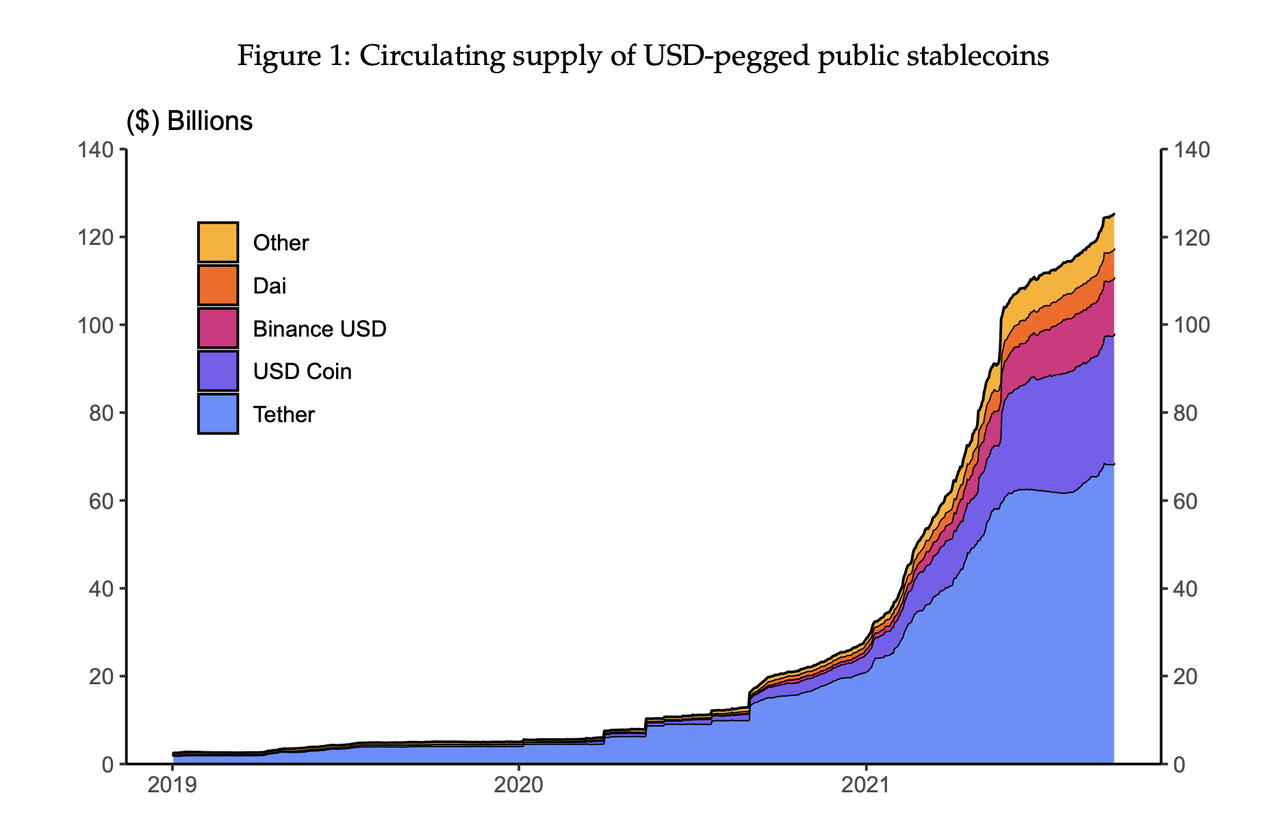
按市值计算的十大与美元挂钩的公共稳定币的流通供应。数据从 2019 年 1 月到 2021 年 9 月。其他类别包括 Fei、TerraUSD、TrueUSD、Paxos Dollar、Neutrino USD 和 HUSD。
公共储备支持的稳定币
大多数现有的稳定币都在公链上流通,例如以太坊、币安智能链或 Polygon。在这些公共稳定币中,大多数由银行存款、国库券和商业票据等现金等价储备支持。这些储备支持的稳定币也被称为托管稳定币,因为它们由充当现金等价资产托管人的中介发行,并以美元或其他法定货币提供 1 比 1 的稳定币负债赎回。
一些公共储备支持的稳定币的充分支持和稳健性受到质疑。特别是,流通供应量最大的稳定币 Tether 同意支付 4100 万美元来解决与美国商品期货交易委员会的纠纷,该委员会指控 Tether 歪曲其美元储备的充足性。其他广泛使用的储备支持具有不同财务审计级别的与美元挂钩的公共稳定币包括 USD Coin、Binance USD、TrueUSD 和 Paxos Dollar。
公共算法稳定币
一部分稳定币使用其他机制来稳定其价格,而不是依赖基础储备的稳健性。这些稳定币通常被称为算法稳定币。虽然储备支持的稳定币在合法注册的公司的资产负债表上作为负债发行,但算法稳定币由专门在公链上运行的智能合约系统维护。控制这些智能合约的能力通常是通过拥有治理代币来赋予的,治理代币是一种专门用于对协议或治理参数的更改进行投票的专用代币。这些治理代币还可以作为对使用稳定币协议的未来现金流的直接或间接索赔。
公共算法稳定币领域具有高度创新性且难以分类。然而,人们通常可以认为这些稳定币的设计基于两种机制:(1)抵押机制和(2)算法挂钩机制。当用户将不稳定的加密货币(如以太坊)存入 Dai 的智能合约协议时,会铸造出有抵押的公共稳定币,如 Dai。然后,用户会收到一笔 Dai(与美元挂钩)的贷款,抵押率超过 100%。如果以太坊存款的价值低于某个阈值,则贷款将自动清算。
相比之下,算法挂钩机制使用自动智能合约通过购买和出售稳定币与相关治理代币来保护挂钩。但是,这些挂钩可能会遇到不稳定或设计缺陷,从而导致「不稳定」,例如算法稳定币 Fei 在 2021 年 4 月推出后短暂脱离挂钩,这就是例证。
机构或私人稳定币
除了在公共区块链上流通的储备支持稳定币外,传统金融机构还开发了储备支持稳定币,也称为「代币化存款」。这些机构稳定币在许可(私人)DLT 上实施,并且它们被金融机构及其客户用于高效的批发交易。最著名的机构稳定币是 JPM Coin。摩根大通及其客户可以使用 JPM Coin 进行日内回购结算等交易并管理内部流动性。
这些私有的、保留支持的稳定币在功能和经济上与某些货币传输者提供的产品相当。例如,Paypal 和 Venmo(Paypal 的子公司)允许用户在其网络内进行近乎即时的转账和支付,并且这些公司持有的余额类似于储备支持的稳定币。关键区别在于使用集中式数据库而不是许可的 DLT。
稳定币的用例和增长潜力
强大的用例正在推动当前各种形式的稳定币的增长。我们总结了这些用例。稳定币当前最重要的用例是它们在公链上的加密货币交易中的作用。投资者通常更喜欢使用公共稳定币来交易加密货币,因为这允许近乎即时的 24/7/365 交易,而无需依赖非 DLT 支付系统或法定货币余额的托管持有。
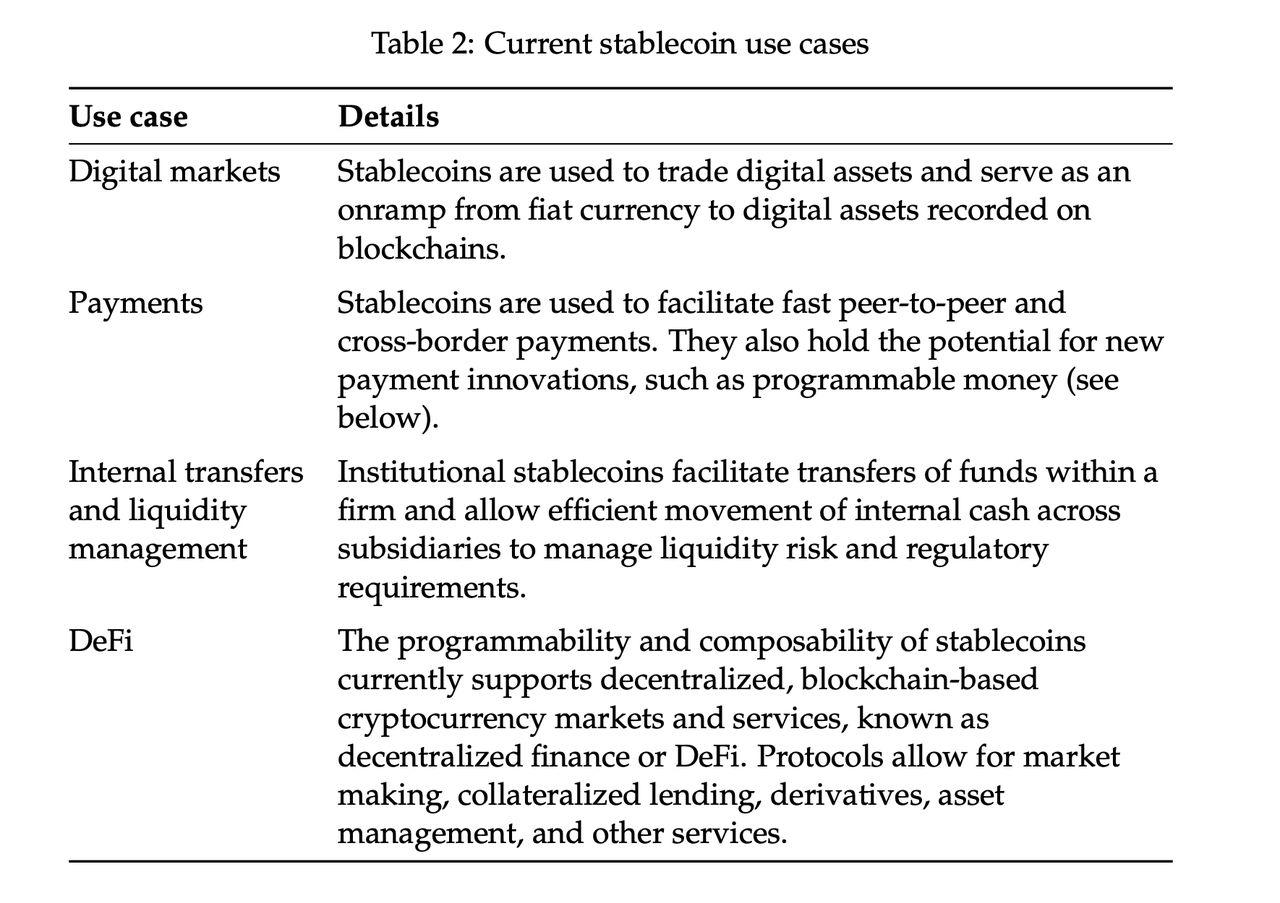
除了用于加密交易外,公共和机构稳定币目前都用于近乎即时的 24/7 非中介支付,费用可能很低。这与跨境转移尤其相关,跨境转账通常需要多天并要求高额费用。公司还使用机构稳定币在其子公司之间几乎即时地转移现金,以管理内部流动性,并促进现有金融市场的批发交易,例如日内回购交易。最后,由于公共稳定币是可编程和可组合的,它们大量用于去中心化、基于公共区块链的市场和服务,称为去中心化金融或 DeFi。DeFi 协议系统允许用户使用稳定币直接和交易母公司参与各种与加密货币相关的市场和服务,例如做市、抵押贷款、衍生品和资产管理,无需传统中介。截至 2021 年 9 月,约有 600 亿美元的数字资产被抵押(锁定)在 DeFi 协议中。
未来增长潜力
稳定币的定义特征、加密安全性和可编程性,支持目前推动现有公共和机构稳定币使用的强大用例。然而,这些功能有可能推动创新超越当前的用例,这些用例主要局限于加密货币市场、某些点对点支付和大型银行的机构流动性管理。展望未来,稳定币技术可能会在多个增长领域看到多样化的实施并推动创新:更具包容性的支付和金融系统、代币化金融市场,以及促进 Web 3 等技术进步的微交易。
更具包容性的支付和金融系统
稳定币有可能刺激支付系统的增长和创新,从而实现更快、更便宜的支付。由于稳定币可用于在数字钱包之间以潜在的低费用几乎即时点对点转移资金,因此稳定币可能会降低支付壁垒并对现有支付系统施加压力以提供更好的服务。这对于跨境尤其重要转账,可能需要几天时间才能清算并收取高额费用。这些费用和延误是低收入和中等收入国家的负担。
稳定币还可能通过 DeFi 的增长来支持更具包容性的金融体系,这可能需要稳定币作为必要的组成部分。需要指出的是,DeFi 面临着严峻的挑战,包括复杂的用户体验、缺乏消费者保护、频繁的黑客攻击、协议功能障碍和市场操纵。此外,几乎所有 DeFi 协议仅支持加密货币或不可替代代币 (NFT) 的交易或借贷。如果 DeFi 协议在当前状态之外成熟并与更广泛的金融市场整合以支持现实世界的经济活动,那么 DeFi 可以鼓励更具包容性的金融体系,允许投资者直接参与市场而无需中介。DeFi 的这种增长可能会推动稳定币使用量的增长。
代币化金融市场
此外,稳定币可能在金融市场代币化方面发挥关键作用。这将需要将证券转换为 DLT 上的数字代币,并使用稳定币进行交易和服务。对于交付与支付 (DvP) 交易,例如证券购买,代币化市场将允许以非常低的成本进行实时结算。这可以提高流动性、交易速度和透明度,同时降低交易对手风险、交易成本和其他市场参与障碍。通过允许代币化资产的部分所有权和更透明的价格发现,这可能特别有利于某些资产类别,例如房地产。对于支付对支付 (PvP) 交易,例如跨货币掉期,代币化也将允许近乎即时的执行,而不是市场当前的传统 T+2 框架,其中掉期的支付由两个业务结算交换发生后的几天。此外,对于这两种交易,代币化金融市场将受益于 DLT 的可编程性,这可以自动化安全服务和监管要求,例如所需的持有期。如果金融市场部分或完全代币化,这可能会推动稳定币使用量的进一步增长。
下一代创新
最后,稳定币具有支持下一代创新的潜力。这种创新的一个例子是 Web 3,它可能从集中式网络平台和数据中心转向分散式网络。在这种范式下,互联网服务和社交媒体平台的收入将从广告转向微交易,得益于高效、集成的在线支付系统的出现。例如,可以想象一个搜索引擎或视频流平台,由稳定币近乎即时的小额支付支持,而不是广告收入和用户数据的销售。如果网络服务的这种转变得以实现,它可能会推动稳定币的进一步增长。
总之,目前稳定币的使用主要是由加密货币交易、有限的点对点支付和 DeFi 驱动的。展望未来,稳定币可能会通过促进更具包容性的支付和金融系统实现进一步增长,金融市场的代币化,以及可能的下一代创新,如 Web 3。
挂钩稳定性
稳定币与其参考价值挂钩的稳定性是一个核心问题。这不是我们论文的重点,但我们在这里简要讨论这个重要问题。在本节中,我们将首先概述当前由公共储备支持的稳定币的挂钩不稳定性的来源,并讨论如何解决这些来源。然后,我们将回顾稳定币如何在数字市场中充当潜在的安全资产,并提供证据证明当前由公共储备支持的稳定币可能已经在加密货币市场中发挥了这一作用。
目前,公共储备支持的稳定币的挂钩不稳定性有两种形式:发行人的投资者赎回风险和二级市场价格错位。前者与稳定币储备的安全性和稳健性有关。如果稳定币持有者对稳定币支持的稳健性失去信心,可能会出现恐慌。对稳定币的挤兑会带来溢出到其他资产类别的风险,因为稳定币储备被抛售或卸载以满足赎回需求。此外,对稳定币的挤兑可能会通过互操作性扰乱依赖稳定币的市场和服务智能合约,造成进一步的困扰。我们认为这种类型的不稳定性可以通过适当的制度和/或监管护栏来解决,例如透明的财务审计以及对稳定币储备的流动性和质量的充分要求。最近在 Quarles(2021) 中提到了围绕赎回风险的担忧及其可以解决的程度。
公共储备支持的稳定币的第二种锚定不稳定形式源于二级市场的供需失衡。由于这些稳定币在中心化和去中心化交易平台都进行交易,因此它们很容易受到需求冲击的影响,这可能会暂时使它们的挂钩脱臼,直到稳定币发行方调整供应。特别是,由于公共稳定币作为基于公共区块链的市场的价值储存手段,这些稳定币在加密市场陷入困境期间经历了高需求,因为投资者急于将其投机头寸清算为稳定币。在这些事件中,主要公共储备支持的稳定币的价格往往会暂时升值,直到发行人调整供应。举个例子,图中显示了 2020 年 3 月 12 日和 2021 年 5 月 19 日的加密货币市场崩盘。第一个事件发生在围绕 Covid-19 传播的担忧的普遍市场动荡时期。第二个事件发生在与大量去杠杆相关的加密市场低迷时期。在这两个时期,随着投机性加密货币比特币和以太坊的价格暴跌 30% 至 50%,主要公共储备支持的稳定币的价格大幅上涨。

对于这些极端加密市场困境的事件,稳定币作为一种数字安全资产升值,而更多投机性加密资产暂时处于自由落体状态,直到稳定币发行人能够增加其供应和购买储备和/或稳定币经历下跌来自套利者的价格压力。这些公共稳定币的行为是独一无二的,与优质货币市场基金不同,后者在 2008 年全球金融危机和 2020 年新冠疫情最严重的时期经历了大量资金外流。
这些事件证明了稳定币在市场困境期间作为数字避风港的潜力。虽然关于公共储备支持的稳定币的金融稳定风险的讨论主要集中在单个稳定币储备形式特有的赎回风险上,但我们的分析表明,反周期二级市场对稳定币的需求可以降低大盘低迷时期的赎回风险。通过适当的保障措施和法规,稳定币有可能提供与传统形式的安全价值相当的稳定性。
稳定币对信用中介的潜在影响
如果稳定币在整个金融体系中得到广泛采用,它们可能会对金融机构的资产负债表产生重大影响。监管机构、市场参与者和学者特别关注稳定币破坏银行主导的信用中介的潜力。在本节中,我们分析了储备支持的稳定币在金融体系中得到广泛采用的几种可能情景。我们专注于储备支持的稳定币,而不是算法稳定币,因为储备支持的稳定币目前是最大的,并且与现有银行系统的联系最密切。利用这些场景,我们强调了稳定币采用对信贷提供的影响如何关键取决于两个因素:流入稳定币的来源和稳定币储备的构成。
我们总结了我们的结果。我们发现,在我们考虑的大多数情况下,信贷拨备可能不会受到负面影响。事实上,用稳定币替代实物货币(纸币)可能会允许更多由银行主导的信贷供应。一个例外值得注意的,可能导致大规模信贷脱媒,稳定币需要得到中央银行储备充分支持,我们称之为狭义银行框架。在这个框架下,赎回风险最小化,代价是更大的信贷脱媒(去中介化)。
流入来源
如果稳定币得到广泛采用,主要流入可能来自三个来源:实物货币(纸币)、商业银行存款和现金等价证券(或货币市场基金)。首先,作为一种数字货币形式,稳定币将取代流通中的部分纸币,尤其是随着经济变得更加数字化。在我们的一些场景中,随着用户从实物现金替代为储备支持的稳定币,我们看到信贷供应增加。这是因为纸币是中央银行的直接负债,被储备支持的稳定币所取代,这取决于储备框架,可以通过贷款或证券购买来创造信贷。
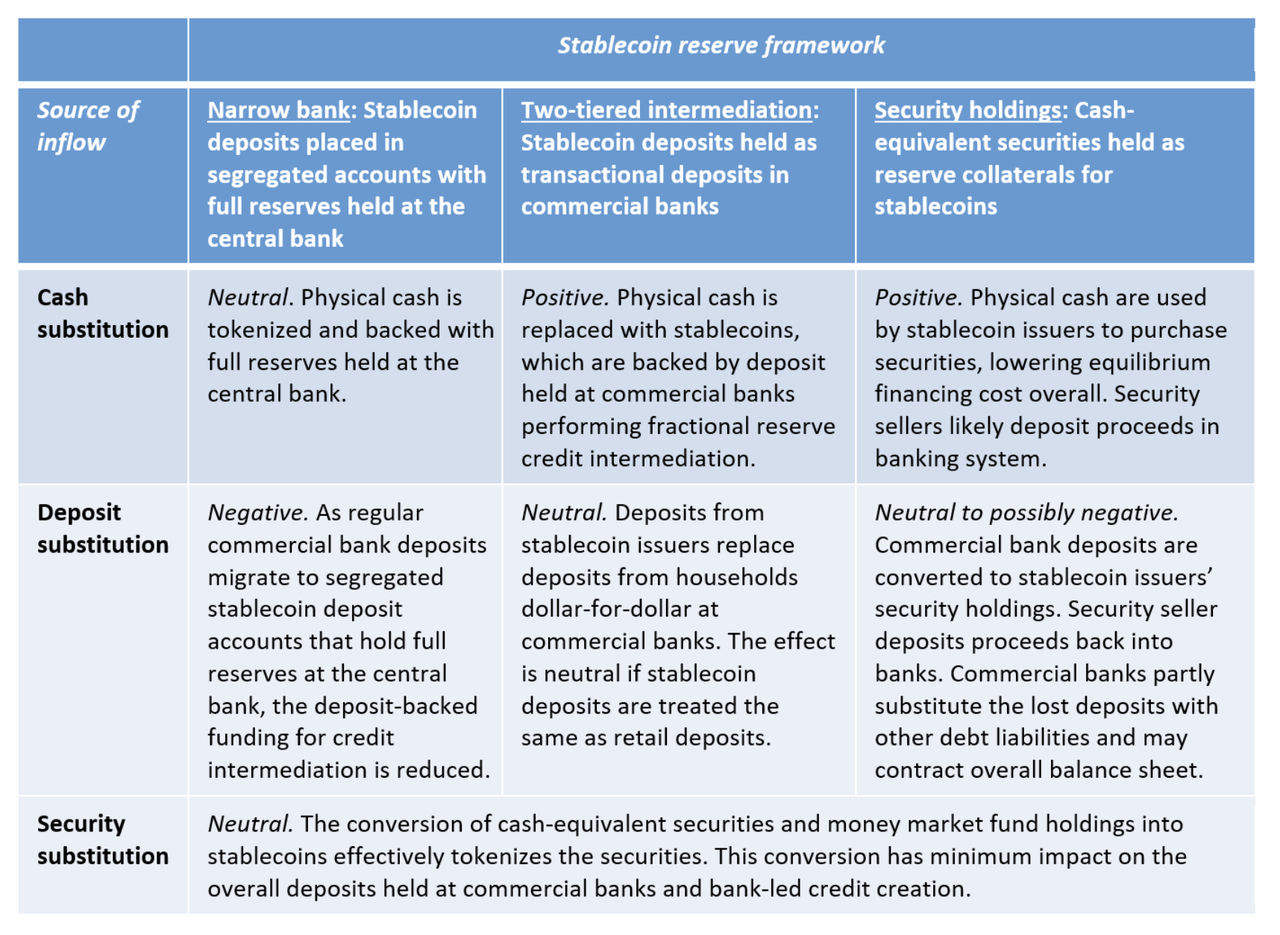
其次,如果家庭和企业更愿意持有稳定币而不是商业银行的传统余额,则稳定币可能会从商业银行存款中流入。政策制定者对这种流入来源非常感兴趣,因为人们普遍担心,大量替代存款可能会扰乱商业银行的信贷供应。我们表明,存款替代对信贷供给的影响可以是积极的、消极的或中性的,这取决于准备金框架。最后,稳定币可能会看到现金等价证券(或货币市场基金)的流入。这可能对信贷供应没有影响,因为它需要将资金循环回银行系统,我们将在后面的部分讨论。
储备构成
广泛采用储备支持的稳定币对信贷提供的影响也取决于稳定币储备的构成。我们提出了三个合理的稳定币储备框架:狭义银行、两级中介和证券持有。如上图。
在狭隘的银行框架下,稳定币需要由商业银行存款支持,而商业银行存款则完全由中央银行准备金支持。等效地,商业银行有可能发行完全的稳定币(或代币化存款)以央行储备为后盾。狭义的银行方法大致相当于一种零售中央银行数字货币,其中数字货币是中央银行的负债,但家庭和公司可以通过商业银行或金融科技公司等中介机构使用。中国人民银行在其国家支持的数字货币(称为数字货币和电子支付)、数字人民币或电子人民币中采用了这一框架。在美国拟议的 STABLE 法案中也提到了要求稳定币在中央银行维持储备的可能性。
虽然狭义的银行框架可以保证稳定币的锚定稳定性,因为它实际上是一种传递中央银行数字货币(CBDC),但这种储备框架构成了信贷脱媒的最大风险。金融压力或恐慌时期可能导致常规商业银行存款大量转移到狭义的银行稳定币中,这可能会扰乱信贷供应。虽然这种信贷中断效应可以通过限制稳定币持有量和差异准备金利率来缓解,但银行对稳定币储备的狭隘方法的整体结构可能会破坏银行系统的稳定。此外,狭义的银行方法可能会导致央行资产负债表的扩大,以适应稳定币发行人对准备金余额的需求。
这些对狭义银行稳定币的担忧反映了对狭义银行更普遍的担忧,美联储已经注意到了这一点。在最近提出的一项将影响狭义银行(官方称为直通投资实体或 PTIE)的法规中,美联储表示「担心 [狭义银行] 可能会以难以预料的方式扰乱金融中介,并且可能也对金融稳定产生负面影响」(条例 D:存款机构的准备金要求,2019 年)。此外,美联储概述了对准备金余额需求的严重担忧,称「[狭义银行] 对准备金余额的需求可能会变得非常大。为了维持理想的货币政策立场,美联储可能需要通过扩大其资产负债表和储备供应来满足这一需求」。
与狭义的银行框架相比,在两级中介框架下,稳定币将由用于部分准备金银行业务的商业银行存款支持。同样,商业银行也有可能发行稳定币或提供用于部分准备金银行业务的代币化存款。需要明确的是,这并不意味着稳定币没有得到充分支持。相反,稳定币发行人依赖商业银行存款作为资产,商业银行利用稳定币和/或稳定币存款实行部分准备金银行业务,这意味着稳定币最终由贷款、资产和中央银行准备金组合支持。它会影响有效地将部分常规存款重新标记为稳定币存款。重要的是,要使银行中介保持不变,在法定准备金率、流动性覆盖率以及其他监管和自我设定的风险限制方面,稳定币存款的处理方式必须与非稳定币存款相同。
最后,稳定币发行人可以持有现金等价证券,例如国库券和优质商业票据,而不是将资金存放在商业银行。这些证券可以通过货币市场基金直接或间接购买。这是当前由公共储备支持的稳定币的发行人采用的主要框架,例如 Tether,美联储主席杰罗姆·鲍威尔最近指出,它「就像货币市场基金」。
场景搭建
在我们的情景中,我们会考虑一个或多个法定储备支持的稳定币在银行系统的程式化版本中获得广泛采用的影响。该银行系统的基线资产负债表如图所示。具体而言,我们考虑家庭和企业用 10 美元替代纸币、商业银行存款或证券的情况,然后我们进行会计工作以确定稳定币的采用会影响中央银行、商业银行以及家庭和企业的资产负债表。我们分析了这种影响如何根据稳定币的储备框架及其流入来源而有所不同。
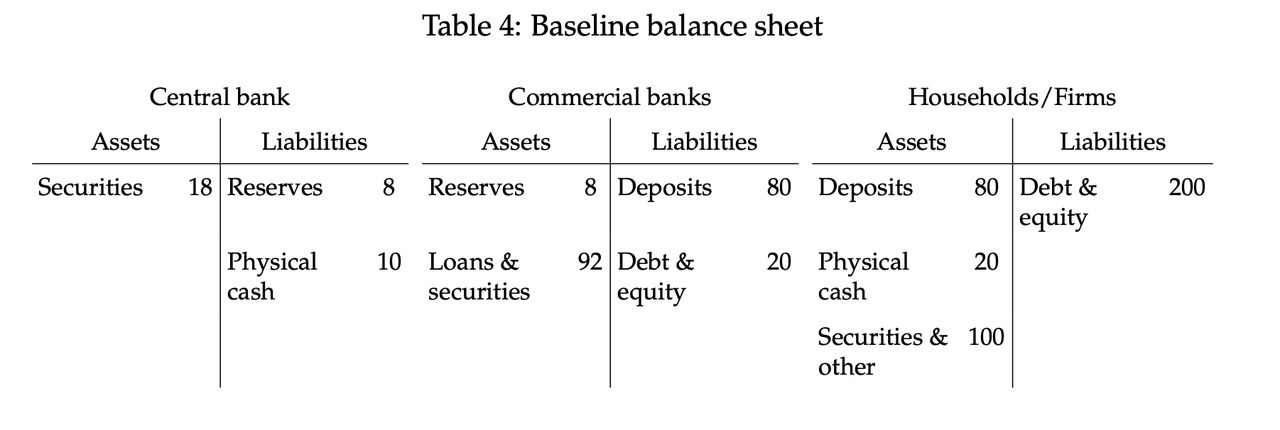
重要的是要注意,在构建这些场景时,我们做了几个关键假设。首先是我们不知道所采用的稳定币的具体形式。我们的场景并不打算分析,例如,广泛采用现有稳定币(如 Tether)的具体影响。我们不区分采用的稳定币是机构代币化存款,还是在公共区块链上流通的稳定币,或其他形式。其次,我们只展示说明性的优势案例。实际上,稳定币可以看到多种来源的资金流入,并持有多种资产作为储备。第三,这些情景没有捕捉到二次连锁效应或反馈循环,也没有解决行业内的异质影响。最后,我们假设商业银行的传统存款有 10% 的法定准备金率。
为了说明支持我们的边缘案例场景的银行系统各个部分之间的复杂流动,我们在图中可视化了我们讨论过的稳定币流入和储备分配的子集。具体来说,我们使用图表来显示商业银行存款(流入 A)和纸币(流入 B)流入稳定币,以及这些资金以商业银行存款的形式分配到准备金(准备金流 A ) 和证券(储备流 B)。
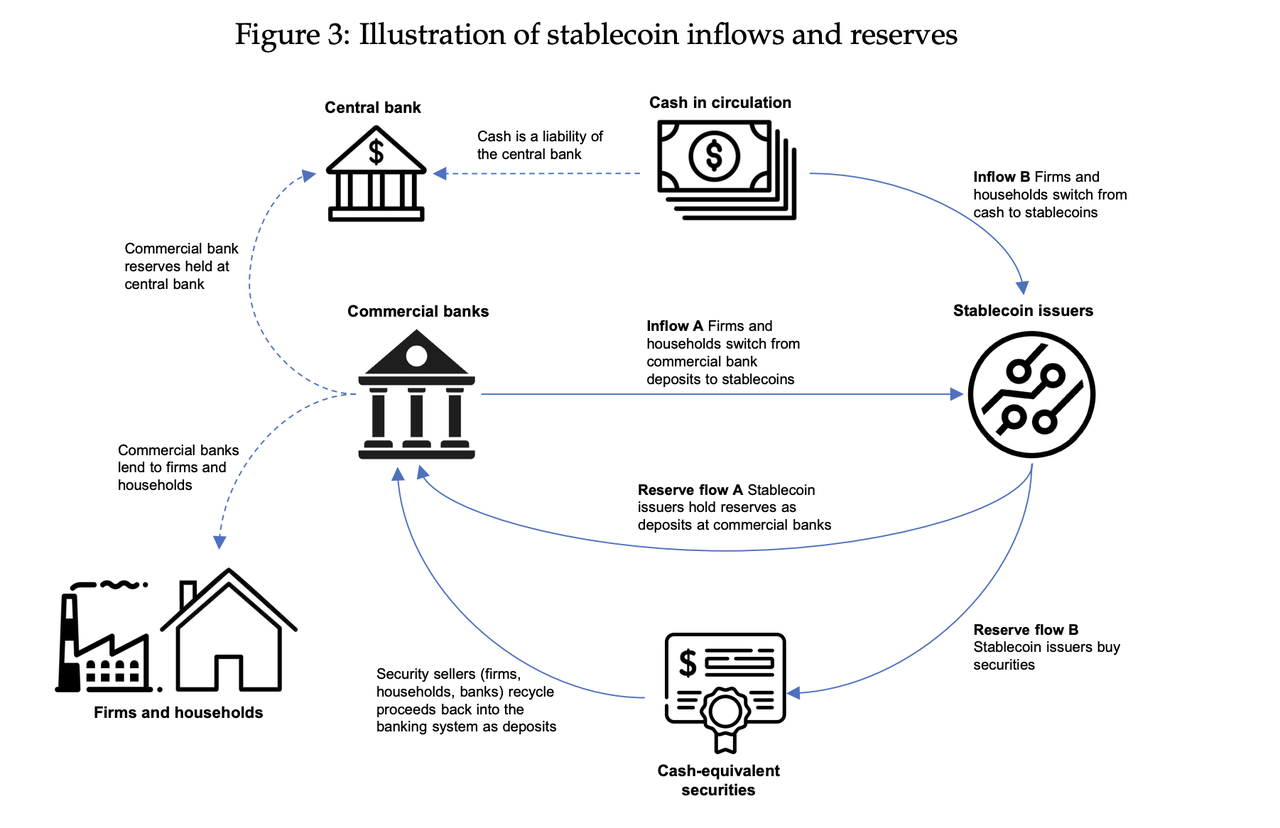
在图中,我们看到了稳定币流入和储备流是如何相互关联的。公司和家庭从存款(流入 A)和纸币(流入 B)替代为稳定币。稳定币发行人将其中一部分资金存入商业银行系统,作为商业银行存款持有准备金(准备金流 A),并用这些资金购买证券作为准备金(准备金流 B)。这些证券购买也将资金循环回银行系统,因为证券的卖方最终会获得证券销售的收益并将其存回银行系统。如图所示,这些流动影响中央银行,中央银行维持现金和中央银行准备金作为负债,以及从商业银行获得贷款的公司和家庭。虽然这张图没有捕捉到这些实体之间的全部流动,但它象征着稳定币的广泛采用如何重新洗牌银行系统内的复杂金融关系。
场景分析
狭义的银行框架
如前所述,狭义的银行框架对信贷拨备构成最大的风险,具体取决于流入的来源。在我们的狭义银行情景中,如表所示,我们发现流入狭义银行稳定币的实物现金流将对信贷供给产生中性影响,而商业银行存款会扰乱信贷供给。
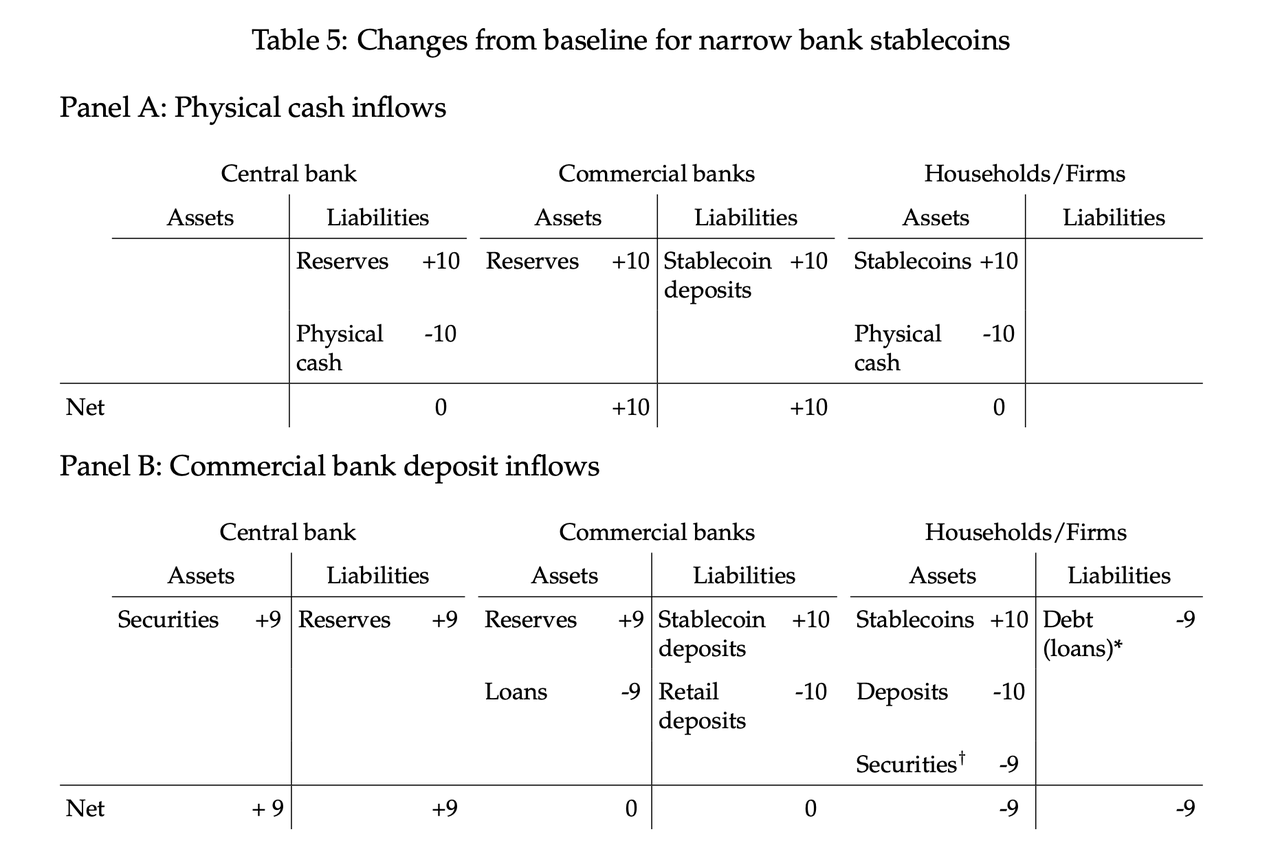
在 Panel A(现金流入情景)中,我们看到稳定币取代了家庭和公司资产负债表上的现金。现金的流入导致商业银行资产负债表和商业银行准备金的间接增加。中央银行的资产负债表进行了重组,准备金负债取代了现金负债。净效应是商业银行资产负债表扩大,但信贷拨备没有变化。这种情况假设银行不受资产负债表规模的限制。也就是说,狭义的银行存款和相关的准备金持有免于杠杆率计算。这种对中央银行储备持有的杠杆率豁免已被不同司法管辖区的监管机构采用。
Panel B 展示了存款迁移到稳定币的狭隘银行场景。由于稳定币存款完全保留在商业银行的资产负债表上,银行必须减少资产持有量以适应非稳定币存款资金的下降。央行资产负债表随后会扩大,以适应对准备金余额的需求增加,而不会抵消现金负债的下降。在这种情况下,我们假设中央银行将通过购买证券来满足增加的准备金需求。这种中央银行宽松的假设是由美联储先前提出的关于狭义银行的裁决提出的,如上所述,与条例 D:存款机构的准备金要求(2019 年)有关。然而,如果中央银行确定其资产负债表的规模,我们在附录的表 A1 中提出了两种替代方案。在第一种替代方案中,商业银行大幅收缩其资产负债表以弥补存款资金的不足。在第二种情况下,商业银行通过发行债务证券来弥补损失的存款资金。结果是银行主导的信贷创造进一步减少。
我们没有想象狭隘的银行稳定币从证券持有量中大量流入的场景。在这种情况下,对信贷拨备的影响可能是中性的。在与上述相同的假设下,中央银行通过(从家庭)购买证券来满足增加的准备金需求,对信贷供应的净影响应该是最小的。与直接持有证券不同,向稳定币的迁移将使家庭拥有由中央银行储备支持的稳定币,而中央银行储备又由证券支持。这种情况还假设增加的狭义银行准备金不受杠杆率的影响,如前所述。
两层中介框架
对于下表所示的两级中介框架,我们发现大量流入稳定币将对信贷供给产生中性至积极影响。Panel A 显示了将现金兑换成稳定币的情况。随着商业银行通过稳定币存款从事部分准备金银行业务,它们的资产负债表随着信贷和证券持有量的扩张而扩大,占扩张的大部分。中央银行在净资产负债表上收缩,准备金略有增加,而现金负债显着减少。家庭积累更多资产,在银行贷款中扩张提供资金。对信贷拨备的影响是积极的。Panel B 显示了具有存款替代的两层中介情景。商业银行和央行总体资产负债表和资产持有量没有变化。唯一的变化是商业银行负债的构成,因为定期存款转为稳定币存款。如前所述,这种情况假设在法定准备金率、流动性覆盖率以及其他监管和自我施加的风险限制方面,稳定币存款的处理方式与非稳定币存款相同。

证券持有框架
如下表所示,广泛采用安全支持的稳定币的影响是最难以预料的。许多情况都是可能的。在 Panel A 中,我们提出了一个场景,其中有证券支持的稳定币看到商业银行存款的流入。我们假设稳定币发行人从商业银行而不是家庭和公司部门采购证券。在这种情况下,随着家庭将存款换成稳定币,商业银行通过发行自己的证券来弥补损失的存款资金。此外,商业银行可以减少其证券组合以弥补存款资金的损失。如果银行主要通过改变证券持有量来调整资产负债表的资产部分,银行贷款组合的规模可能保持不变。在这种情况下,由于银行准备金的损失,央行的资产负债表也略有收缩。
Panel B 展示了家庭将持有的现金等价证券换成稳定币的情景。这将导致类现金证券的有效代币化,而不会直接影响银行系统的信贷供应。我们还考虑了另一种情况(未显示),其中有证券支持的稳定币经历了来自家庭和公司部门的存款流入,同时向商业银行出售证券。证券卖方是家庭和公司部门,而不是表 7 Panel A 中描述的商业银行。对信贷提供的净影响是中性的,因为购买稳定币的家庭和公司持有的商业银行存款余额最终被回收回通过将它们转移给向稳定币发行人出售证券的其他家庭和公司来实现银行系统。这种证券持有量的重组在图 3 中通过流入 A 和储备流 B 进行了说明。最终结果是资产负债表的变化,与 Panel B 相同。
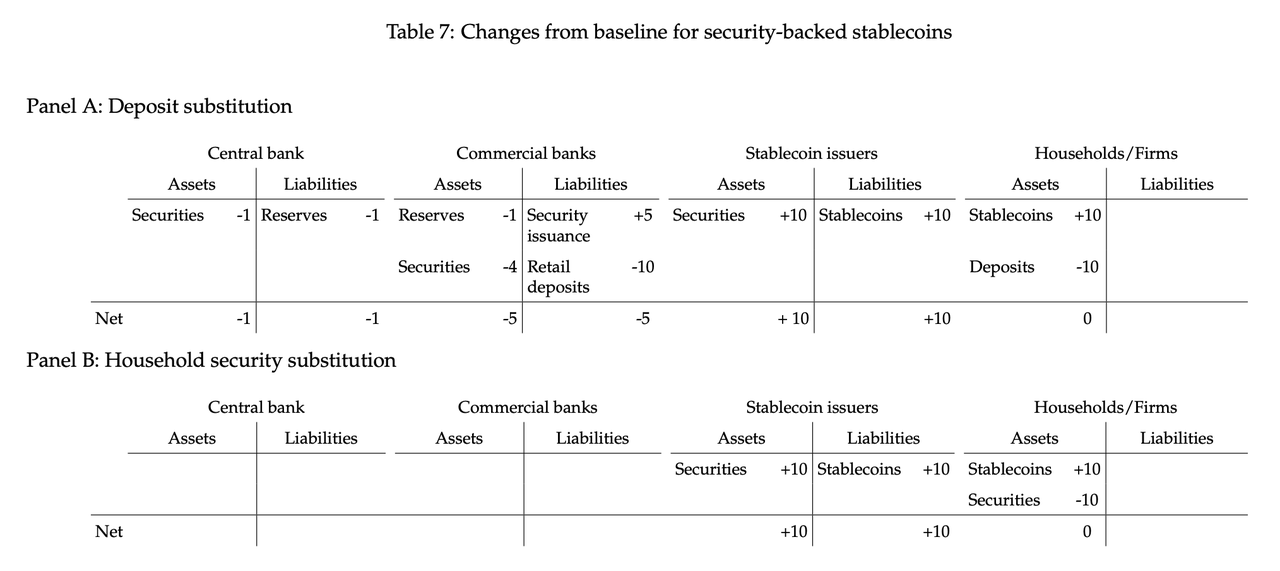
最后,我们没有描述有安全支持的稳定币从实物现金流入的场景。然而,这可能对信贷创造产生中性或积极的影响。如果稳定币发行人使用纸币购买现有证券,而这些纸币最终没有存入银行系统,这不会影响信贷供给,因为这将构成纸币与证券的直接交换。然而,如果购买现有证券的纸币存入银行系统,或者如果这些纸币用于为发行新证券提供资金,这可能会通过增加商业银行的贷款和证券购买来增加信贷供给,或通过降低发行证券的均衡成本。总而言之,可能的影响是信贷供应的适度增加。
总结
随着数字资产获得更广泛的采用以及可编程数字货币的用例得到澄清,稳定币在过去一年中大幅增长。这种快速提升引起了人们对银行活动和传统金融体系可能产生负面影响的担忧。在本报告中,我们讨论了稳定币的当前用例和潜在增长,分析了锚定不稳定的历史事件,并说明了稳定币对银行系统影响的不同情景。如引言所述,本文并未考虑稳定币对金融稳定、货币政策、消费者保护和其他重要的未探索问题的所有潜在影响。我们在一系列合理假设下关注资产负债表效应和信用中介。
我们研究了储备支持的稳定币,发现稳定币采用对传统银行和信贷提供的影响可能因流入来源和稳定币储备的构成而异。在各种场景中,两级银行系统既可以支持稳定币的发行,又可以维持传统的信用创造形式。相比之下,狭义银行稳定币框架可以带来最大的稳定性,但可能会带来信贷脱媒的潜在成本。最后,如果认为与美元挂钩的稳定币有足够的抵押品,那么在市场困境期间,与其他加密资产相比,与美元挂钩的稳定币可以作为避风港。



